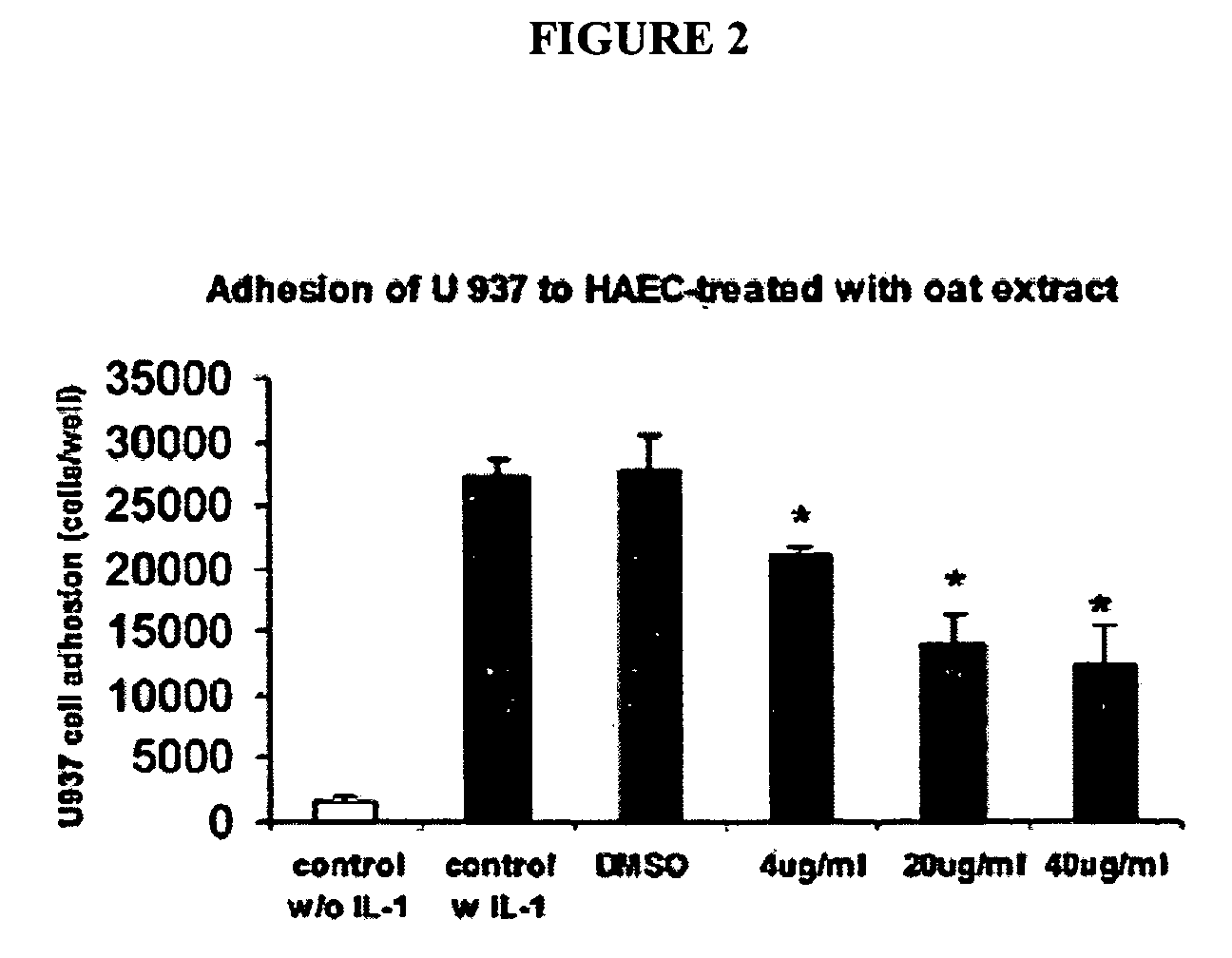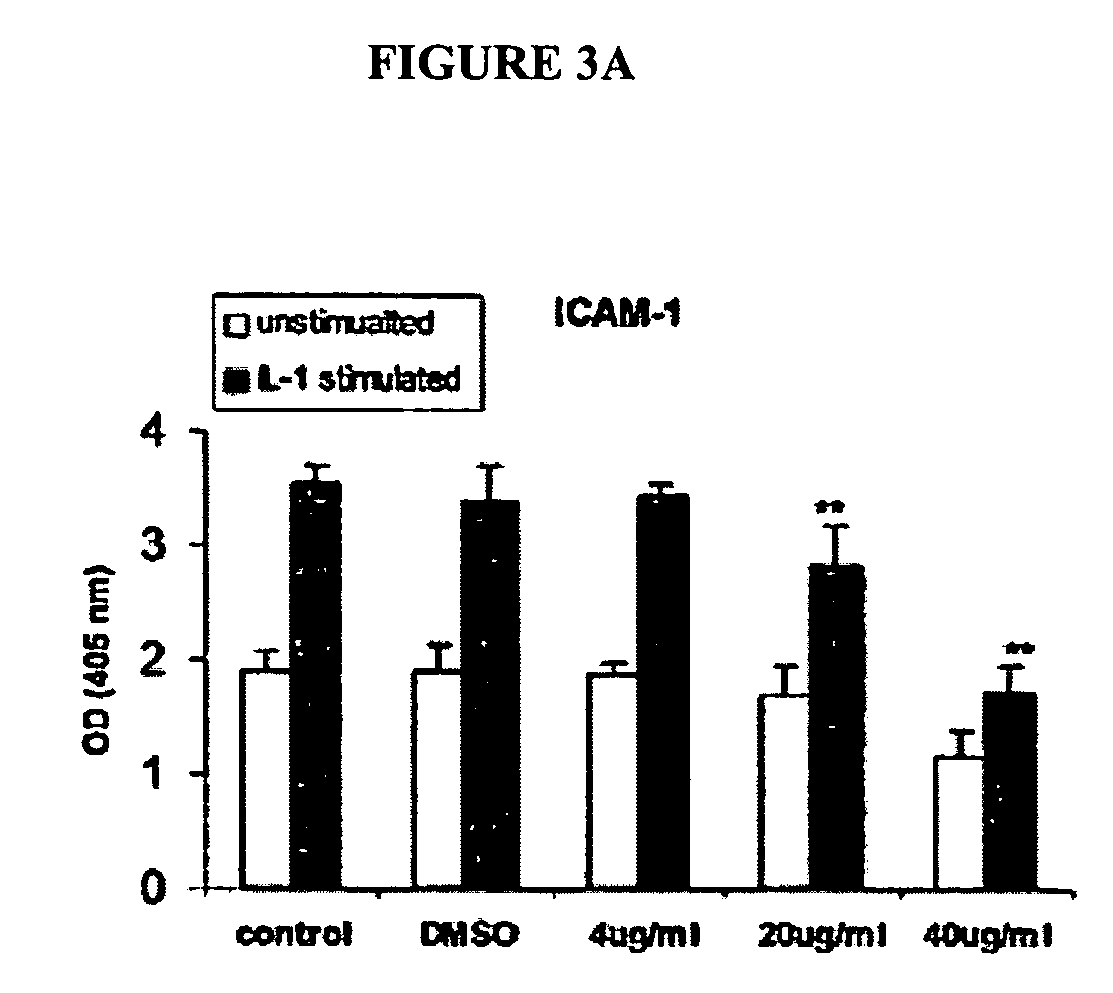Therapeutic avenathramide compounds
a technology of avenathramide and avenathramide, which is applied in the direction of biocide, plant/algae/fungi/lichens, peptide/protein ingredients, etc., can solve the problems of increased platelet aggregation, abnormal vasospasm, and impaired vasodilatation, and achieve the effect of slowing down the disease progression
- Summary
- Abstract
- Description
- Claims
- Application Information
AI Technical Summary
Benefits of technology
Problems solved by technology
Method used
Image
Examples
example 1
Materials and Methods
(i) Cell Culture
[0145] HAEC were purchased from Clonetics Laboratories (San Diego, Calif.) and cultured in MCDB-131 medium (Sigma Chemical, St. Louis, Mo.). Passages 6-8 were used in this study. The culture medium contained 2% fetal bovine serum (FBS) (Gibco, Grand Island, N.Y.), 2 mmol / L L-glutamine (Gibco), 100 U / mL penicillin (Gibco), 100 U / mL streptomycin (Gibco), 1 ug / mL hydrocortisone, 0.01 ug / mL epidermal growth factor (EGF), 0.5 mL bovine brain extract (BBE), 0.5 μg / mL amphotericin B (Sigma). RACE were seeded in the 1% gelatin (Sigma) coated T-75 flasks, 24-well plates and 96-well plates. The medium was changed every other day until the cells grew to confluence. 6-8 passage cells were employed and experiments were conducted in triplicate or quadruplicate. U937 cells (American Type Culture Collection, Rockville, Md.) grew in suspension culture in RPM1-1640 medium (Life Technologies, Grand Island, N.Y.) supplemented with 10% FBS, 2 mmol / L L-glutamine, 1...
example 2
Cytotoxicity Test
[0160]FIG. 1 shows oat extracts and DMSO cytotoxicity on HAEC. Confluent human aortic endothelial cells (HAEC) were incubated with 0, 4 and 40 μg / mL oat extracts and 0.04% DMSO for 24 h at 37° C. Cytotoxicity was measured by Trypan blue exclusion test. Data are the mean±SD of 3 experiments, each performed in triplicate. *p<0.05, **p<0.01 compared with control. Oat extract had no cytotoxicity on HAEC up to the 40 μg / mL concentration tested. 0.04% DMSO in MCDB-131 medium solution showed also no toxicity on HAEC during 24 hr incubation.
example 3
Effect of Oat Extract on Monocyte-HAEC Adhesion
[0161] The effect of oat extracts on monocyte-endothelial cell adhesion is shown in FIG. 2. Confluent human aortic endothelial cells (HAEC) were incubated with 0, 4, 20 and 40 μg / mL oat extracts for 24 h at 37° C. The HAEC were then stimulated by interleukin (IL)-1β (5 μg / mL) at 37° C. for 6 h. A total of 107 U937 cells were added onto HAEC and incubated at 37° C. for 30 min. The adhesion of U937 cells to HAEC was determined as described in Example 1. Data are the mean±SD of 3 experiments, each performed in triplicate. *p<0.05, **p<0.01 compared with control. There was trivial adhesion of U937 to HAEC without IL-1β stimulation. Pre-treatments of HAEC with oat extracts or DMSO contributed little to that basal adhesion (data not shown). However, when HAEC was stimulated with 5 ng / mL IL-1β for 6 h, their adherence to U937 cells increased (p<0.01) (FIG. 2). Pretreatment of HAEC with oat extracts for 24 h before activation with IL-1β signif...
PUM
| Property | Measurement | Unit |
|---|---|---|
| Concentration | aaaaa | aaaaa |
| Adhesion strength | aaaaa | aaaaa |
| Therapeutic | aaaaa | aaaaa |
Abstract
Description
Claims
Application Information
 Login to View More
Login to View More - R&D
- Intellectual Property
- Life Sciences
- Materials
- Tech Scout
- Unparalleled Data Quality
- Higher Quality Content
- 60% Fewer Hallucinations
Browse by: Latest US Patents, China's latest patents, Technical Efficacy Thesaurus, Application Domain, Technology Topic, Popular Technical Reports.
© 2025 PatSnap. All rights reserved.Legal|Privacy policy|Modern Slavery Act Transparency Statement|Sitemap|About US| Contact US: help@patsnap.com



